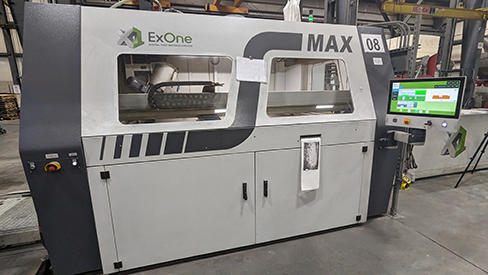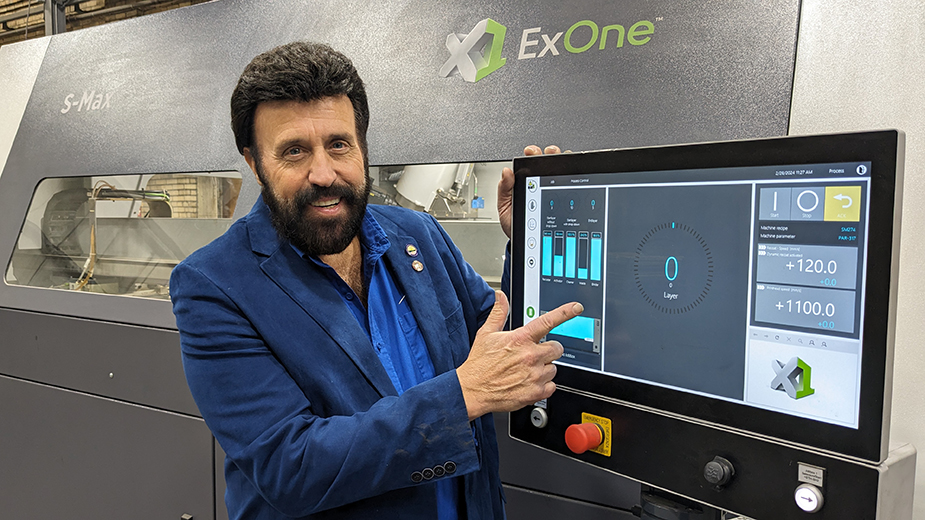BOARDMAN – Mark Lamoncha stands in a mostly empty space that was once crammed with conveyors, ovens, mixers and other equipment used to produce chocolates and other treats.
“I never realized what was here,” Lamoncha says as he walks into a room now equipped with shiny air compressors. “This room was filled with big, round tanks where they used to mix the chocolate.”
Less than a year ago, the building at 8301 Market St. in Boardman was cranking out products for Gorant Candies – a confectionary that was well-known in northeastern Ohio. After its operations closed, the vacant building presented an opportunity for Lamoncha, whose Leetonia-based company is now in the midst of transforming it into a textbook example of modern industrial manufacturing.
In October, Lamoncha’s company, Humtown Products, purchased the 58,000 square-foot building for $3.5 million with a whole new purpose in mind. By the end of April, the space will be crowded again – not with mixing vats, cutters and large conveyance systems – but with sophisticated 3D printers that mostly serve the foundry industry.
Humtown is in the process of relocating its additive manufacturing division, Humtown Additive, from Leetonia to the Boardman site. The new building now houses a single 3D printer, the company’s newest purchase. By the end of April, the company plans to move its remaining 11 printers to the new site.
“I’m trying to keep the Siemens machines – five in all – in the ‘yellow room,’” Lamoncha, Humtown president and CEO, says, referring to the color of the walls. The remaining seven printers will be installed in the “blue room,” while two other rooms, a “red” room and a “green” room, could be used for other additive manufacturing-related disciplines, he says. On average, it takes between two to four days to break down and move a single 3D printer.
The $5 million project includes the building’s purchase and renovation, which involved replacing aging fluorescent lights with LED fixtures, widening entranceways to accommodate the size of the printers, installing new air compressors, as well as a central vacuum system.
Humtown, established in 1959, began as a traditional manufacturer of sand cores used in the foundry industry. Over the last 10 years, however, the company has transitioned from using the conventional method of manufacturing these sand molds to 3D printing, a move that Lamoncha says is nothing short of transformational for his company and the industry.
Essentially, employing additive manufacturing removes an entire step from the traditional process of producing sand molds, Lamoncha says. In the past, creating a mold for a metal component would first require the creation of a pattern, or a prototype shape of the object. Sand and a bonding agent would be applied around the pattern to create a core, into which the customer pours molten metal to form a part.
“A lot of the pattern making has faded away as a trade,” Lamoncha says. Through additive manufacturing, a 3D printer can import a digital design and build the sand core from the ground up, using the same materials and removing the need for a pattern. The result is an expedited turnaround for customers.
“Original equipment manufacturers need speed to market,” Lamoncha says. “They don’t need to spend eight to 12 to 20 weeks of going to a machine shop and making the tooling when they could go from CAD (computer aided design) to casting in a matter of 24 to 36 hours,” he says.

Humtown began its transformation about 10 years ago, when the company first inquired about the potential of adopting additive for its operations, says Barb Ewing, CEO of the Youngstown Business Incubator.
“Mark and his team truly had an amazing vision of what the technology could do and are transforming a very old industry,” she says.
Support from YBI, Youngstown State University and America Makes – the country’s first innovation institute devoted to additive manufacturing – helped the company secure initial funding toward the purchase of its first 3D printer, Ewing says.
“That was really the foundation of us being able to move forward to build the expertise in that industry,” she says.
Indeed, metal casting had not changed much since the Bronze Age, Ewing adds. “Mark has taken that very traditional industry and blazed the path forward to adopt this technology. You can do things better, faster – not necessarily cheaper – and do things you can’t do using traditional pattern making processes.”
Ewing says manufacturers such as Vallourec, which operates an extensive pipe and tube mill in Youngstown, have used 3D printed sand cores to improve its piercing points. “They were able to redesign their piercing points so they don’t heat up as fast,” she says.
Meanwhile, Humtown continues to operate its 11 3D printers out of its leased location in Leetonia. Humtown’s conventional sand core operations are in Columbiana.
Much of the expansion in the additive field has come over the last six years, he says, noting that most of Humtown’s 62 employees now work in its additive division.
The technology has helped open other markets for Humtown.
Among these is the burial monument market, Lamoncha says. Humtown is conducting research and development on 3D-printed burial monuments that present a lower-cost alternative to memorials cut from stone. “I want to make it more affordable for people to not have to get cremated,” he says. “What we’re trying to do is to get a like-marble finish on these,” he says.
The company is also working on developing pet urns using the same 3D printing process. As an added benefit, Humtown is working on a means to transfer a printed image of the owner’s pet onto the urn.
“Within a year, we’d like to bring monuments to the market that are actually at a lower cost so that more people can choose burial,” Lamoncha says.
Other opportunities outside of sand core printing have also presented themselves over the last year,.
For example, Lamoncha took the time to meet skateboard champion and businessman Tony Hawk during his visit to Youngstown State University in September 2022. It was this visit that inspired Lamoncha to build 3D printed prototypes of skateboard ramps using a composite of sand and a high-strength polymer. “I shared with him that these were possible,” he says.
Lamoncha says it’s the same type of materials that were used by FreshMade to create the celebrated life-size bobble-head statues of then presidential candidates Hillary Clinton and Donald Trump in 2014.
“There’s an opportunity maybe in the near future where a city would want one in their park,” he says. “You could make all kinds of slopes and shapes. It’s really taking that whole idea out of YSU and FreshMade and making other products for other industries.”
Lamoncha says advances in 3D printing have helped expand Humtown’s product ambitions, and the new building in Boardman suits its needs perfectly.
“I’m always looking for what could be next,” Lamoncha says. “That’s what we’re working on.”
Pictured: Mark Lamoncha demonstrates the functions of an ExOne 3D printer.
